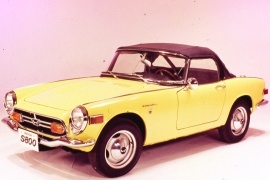HONDA S800 Models/Series Timeline, Specifications & Photos
First production year: 1966
Engines: Gasoline
Body style: Convertible (spider/spyder, cabrio/cabriolet, drop/open/soft top)
Honda introduced the S800 lineup at the 1965 Tokyo Motor Show as a replacement for the S600, and the new model came as a roadster or as a coupe.
Back in the early ‘60s, Honda was mostly known for its motorcycles. But Soichiro Honda’s dreams were much higher, and he decided to go into the car market. The company started slow, with lightweight roadsters. And then came the S800. It was a model that Honda exported and became its most representative car. The automaker adapted the little roadster to comply with U.S. regulations, but it never reached the North American market. Even though it couldn’t sell more than 12,000 units in four years, this vehicle became a milestone in the automaker’s heritage thanks to its innovative engineering solutions. It was the last S-model produced by Honda before the S2000 in 1999.
While automakers in America or Europe focused on high-powered coupes or small-sized vehicles, Honda came with an economical and fun lightweight sportscar. The car’s front fascia was simple, featuring two round headlights and a trapezoidal grille crossed by a thick chromed slat that sported the Honda badge and the turn signals. Underneath, the automaker placed a profiled metallic bumper, which looked so much different than the straight ones the European car manufacturers offered.
From its profile, the small-sized sportscar showed a long hood compared to the car’s size and a steep and curved windshield. The tiny doors featured chromed door handles and mirrors, while behind them, the car ended into a slightly sloped down rear deck. At the back, the automaker installed corner-mounted taillights, depending on the market. In the UK, the car featured horizontal ones mounted on the rear fascia above the chromed metallic bumper.
The cockpit offered room for the driver and their side passenger, divided by the transmission tunnel that housed the gear selector and a center armrest. Honda also installed a center console where it placed the ashtray, the cigarette lighter, and the controls for the ventilation system. The minimalist dashboard sported a broad instrument cluster extended towards its center featuring larger dials for the speedometer and tachometer and two additional gauges for fuel level and water temperature. Behind the cabin, the automaker left enough room for the retractable canvas roof.
But the most significant difference compared to any other car on the road from those times was under its skin. Honda installed a 0.8-liter inline four featuring dual overhead camshafts and four carburetors. It could scream at 8,500 rpm at a time when most other automakers struggled to reach 5,500 rpm. Its four-speed manual gearbox sent the power to the rear wheels. The first about 1000 units featured chain drive, but the rest were fitted with regular drive shafts.
